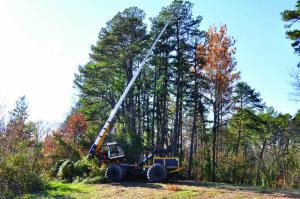All-terrain tree-trimming machines enable Illinois contractor to clear pipeline right-of-ways faster and safer.
While keeping oil and natural gas pipeline right-of-ways free of inspection-obscuring tree branches, crews at Bolin Enterprises encounter all kinds of terrain and weather. But thanks to all-terrain tree trimming machines made by Jarraff Industries, employees can safely press on, regardless of the conditions.
“We work in all different kinds of conditions, ranging from swamps and mud to hilly terrain,” says Troy Bolin, major acquisitions director of Bolin Enterprises, a pipeline and tank maintenance company based in Casey, a central-Illinois town. “It’s rarely perfectly flat where we go, so having the rubber tracks on the Jarraffs make life a lot easier. They work great in dry conditions as well as mud and snow — pretty much anything Mother Nature throws at us.
“That’s critical to our productivity,” he adds. “If we have to wait on the weather — have six crews waiting for, say, two weeks for weather to break — that would eat into our profits fairly quickly. But if we keep the equipment underneath our guys, we can continue to move along productively, which is important when you have hundreds of miles of canopy to trim each year.”
Bolin Enterprises is a fully diversified company. Along with pipeline and tank maintenance, the company also clears right-of-ways, does pipeline excavation, cleans tanks, repairs and coats pipelines and offers hydroexcavating, industrial vacuum, erosion control and pig-tracking services.
THE MACHINES
The company currently owns six Jarraff all-terrain machines, four with rubber/steel tracks and two that utilize oversized rubber tires. The units feature a 75-foot-long telescoping, hydraulically operated fiberglass boom with 90-degree range of motion; a 24-inch carbide circular saw blade that rotates at 3,200 rpm; a hydraulically powered turntable below the operator’s cab that provides 360-degree range of motion and up to 40 degrees of lateral tilt; a 130 hp Cummins diesel engine; a 20,000-pound winch with 150-feet of cable; and an 8-foot-wide, front-mounted push blade.
“One of the biggest features for us is the rubber tracks, which keep most of the machine’s weight closer to the ground, thereby providing greater stability for the machine and the operator,” Bolin says. “When it’s wet and/or muddy, those tracks keep it afloat so we can keep going. Additionally, the tracks don’t impact the ground as much.” He also says the machines are very maneuverable, which allows them to work where other machines might not fare as well.
The company mainly uses the tree trimmers to keep the tree canopies along pipeline right-of-ways in check. Properly trimmed trees make it easier for the pipeline companies to perform aerial inspections to check for leaks and encroachments, such as excavations or building activities within their right-of-ways. The company does canopy trimming for pipelines primarily in Illinois, Indiana, Kentucky, Michigan and Ohio.
On average, crews strive to trim about 2 miles of tree canopy a day, depending on the terrain, percentage of growth and density of growth. “If we do 2 miles a day, that’s a very efficient pace,” Bolin says. “But if we’re in a swamp-like section, we might do only 1,000 to 2,000 feet a day. It all depends what we’re getting into.”
REMOTE OPERATION
But no matter what the terrain, Bolin says he rests assured that crews are working safely because of a unique feature Jarraff teamed with him to develop: remote-control operation from up to 300 feet away. Three of the company’s machines are equipped with remote-control operation and Bolin says all future purchases will include the feature.
“These machines are fairly simple to use and most anyone could run one with a bit of training,” Bolin says, noting that operators can control them with two four-way joysticks. “But it takes a certain kind of operator to run a canopy trimmer, as it can get a little nerve-wracking when you encounter hills, ditches and creeks.
“When an operator gets into a situation where they may feel a bit uncomfortable with the terrain, they can exit the machine and switch to remote operation,” he continues. “This gets them out of the cab and relieves their anxiety about the situation. Theoretically, you could sit in a pickup truck and operate it, since it has a range of 300 feet. The remote operates the same as the controls in the cab, so you’re capable of doing the same things with the remote that you can do if you’re sitting on the cab.”
The remote-operation feature also makes it easier for the company to hire employees who might otherwise not be interested in running the machines because they feel it’s dangerous.
“It’s difficult to find trimmer operators who are experienced in challenging terrain,” Bolin notes. “Plus younger guys these days are so used to playing video games, the remote operation opens up a new ball game for us.”
From a productivity standpoint, Bolin says he also likes the fact that the saw blade tilts, as opposed to remaining locked in a vertical position. This gives operators more flexibility because they can cut off the tops of trees, not just trim off branches.
As for return on investment, Bolin says the units pay for themselves, as long as they’re out working regularly. He says that typically, it’s easy to make a decent profit with specialty machines because fewer contractors are likely to own them. “I like to have a machine pay for itself within three years and these machines fit the bill,” he says. “They’re pretty good little money makers.”










Comments